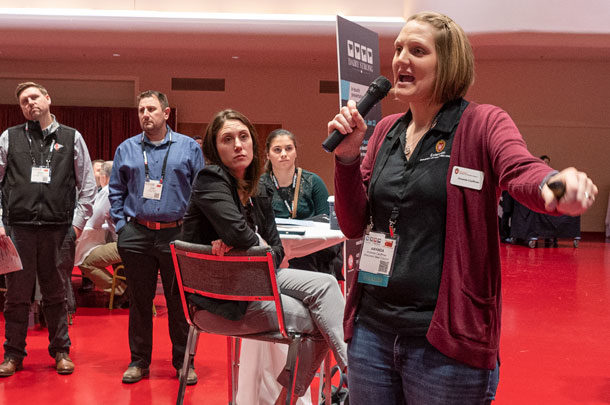Buyers continue to see value in dairy-beef animals at sale barns but are becoming more discerning as more crossbreds enter the marketplace.
Amanda Cauffman, a University of Wisconsin Extension agriculture educator in Grant County, Wisconsin, made that observation while talking about breeding-program considerations during the Dairy Strong conference Jan. 22 in Madison, Wisconsin.
Well-planned crossbreeding of dairy steers with beef steers can lead to increased market value, improved feed efficiency and daily rate of gain, and fewer days on feed, she said. Well-planned is the operative word.
“Considering how best to cross dairy with beef is important, because there are a lot of these calves entering the market that aren’t fulfilling expectations when it comes time to send them to harvest,” Cauffman said.
Dairy farmers can help their pocketbooks by thoughtfully considering their sire selections to get modern, well-managed Holstein steers, which are high-quality animals, she said. They have comparable quality grades with less external fat than common beef breeds, similar taste and tenderness compared to common beef breeds, similar taste-panel evaluations, and consistency in performance as a breed.
Cauffman reviewed the weaknesses of the modern Holstein steer: lower dressing percentages than common beef breeds, smaller ribeye size and elongated ribeye shape compared to common beef breeds, and risk of exceeding packer height or weight restrictions if not properly managed. Also, there are a limited number of harvest facilities for Holstein processing, resulting in fewer competing bidders.
Choosing sires that can improve upon these weaknesses and capitalize on strengths is the crucial part of selection, Cauffman said.
Farmers must consider many facets when assessing sire characteristics.
Semen cost, sire conception rate, calving ease and hair coat color are the chief considerations for dairy farmers as they choose. Feedlot farmers keep an eye toward carcass value and weight, as well as feed efficiency traits, greater ribeye area, improved muscling, moderate frame scores for Holstein matings, increased carcass weights for Jersey matings and the use of homozygous polled bulls.
When dairy steers are fed and managed correctly, they grade well with similar quality grades to the equivalent beef steer, Cauffman said. There is also less external fat at the 12th and 13th ribs. This might mean beef sire selection for ribeye, carcass weight and frame size may need to be prioritized higher than marbling.
Dairy genetics for milk production and body conformation have changed over the past several decades. North American beef breeds have experienced similar genetic changes. Many beef herds have incorporated outside genetics to get more desirable hair coat coloring, while other herds have accepted hybrid breeding.
One major drawback of crossbreeding is the lack of group uniformity, Cauffman said. This is typically caused by random sire usage without careful consideration given to carcass traits in addition to improper herd management. Forward-thinking dairy farmers can resolve this issue by carefully weighing all sire options.
“Improving upon what’s already in the marketplace is the primary goal of fine-tuning crossbreeding efforts for meat production,” she said.
The Dairy Strong Bloggers series is brought to you on behalf of the Dairy Strong virtual conference, Jan. 19-21, 2021. This event focuses on cutting-edge technology, cultural trends and the future of the dairy community. Learn more and register at the Dairy Strong website.







